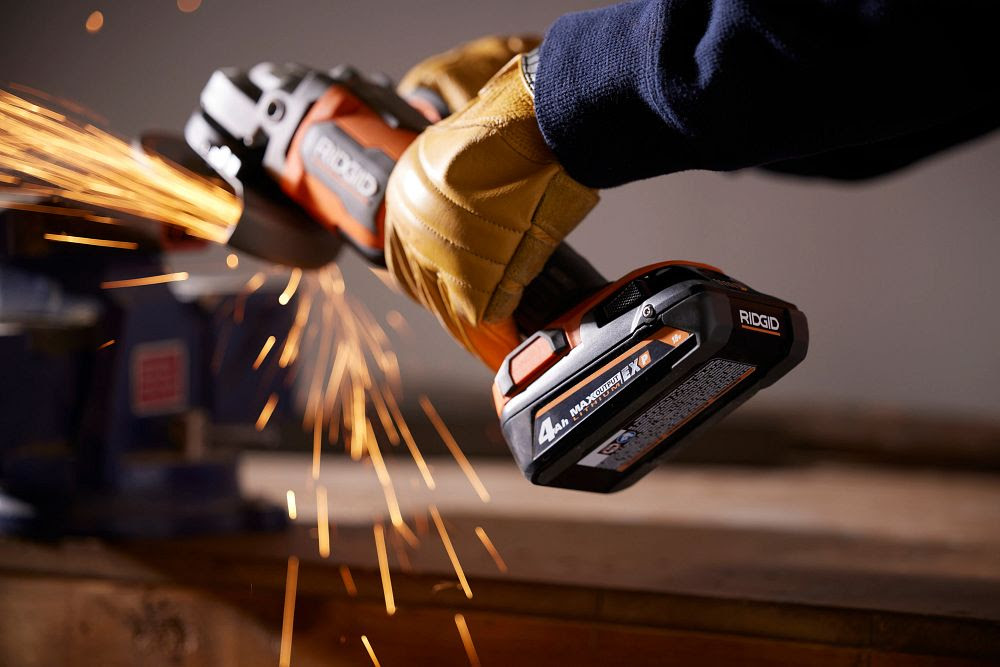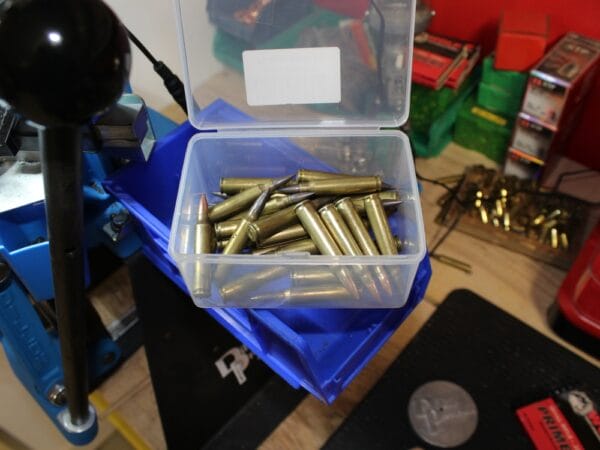
In my first reloading article, I introduced shooters to the world of reloading. We looked at components, equipment, procedures, etc. For the second part of this series, we will look at reloading .223. This is one of the most popular calibers to reload, along with 9mm. Even though you can buy either caliber in bulk, with the recent spike in prices, it’s still cheaper, in the long run, to “roll your own.”
This article will delve into the question of why you’d want to reload this caliber, the equipment that you need to reload this rifle caliber, its components, and other general information. Hopefully, I can throw in a few tips along the way.
Why Reload The .223?
Let’s look at the question of why we would want to reload this caliber, especially when you can buy it in bulk as mentioned above. There is more than one answer to that question.
One thing that reloading .223 can do for you is give you total control over your loads…
- Want to shoot a certain bullet that you can’t find in loaded ammo in a store or online?
- How about you need to load some lower-pressure loads that are down a grain or two of powder for a new shooter?
- Do we need to make different loads to be shot in a bolt action versus those bound for an AR?
Load your own. This alone is the reason that many rifle shooters choose to reload. You are in command and can do whatever you want to do — within reason, of course — where loading this versatile caliber is concerned.
Curious about what’s needed to reload? I described the four basic types of reloading presses in the first article, so you can get information there about the choices you have where they are concerned. I also describe the other equipment you’ll need.
The second (huge) reason to reload is that it can save you some money. There is something to think about where this is concerned, though… you have to own the equipment first. If you run out and buy a reloading press, dies, calipers, powder scale/measure, components, and other tools of the trade, you will not realize many savings initially. You will, however, make progress in the amortization of the cost of your set-up with each round you load.
In my experience (I’ve been reloading and helping new reloaders since 1978), most new reloaders buy a set-up to load one or possibly two calibers. This is great, as you can branch out to other calibers as needed. But if you buy everything needed, even for just the .223, you’re still out a pretty penny. You will eventually re-coup the cost, as I said above… it will just take time.
Live Inventory Price Checker
|
|
A |
A |
$ A |
Components: Let’s Do The Math
OK… you’ve bought what you need in terms of equipment and components. How much will that cost? A reloading kit with everything you need to get going could cost anywhere from about $150 to easily times that amount… that’s a topic we’ll tackle in a bit more detail in the third article of this series, so stay tuned.
What about components? Let’s do a quick breakdown of what you may expect to spend on components.
Brass/Case: We’ll assume you’ve hung to your fired brass or have been gifted some by your non-reloader shooting buddies. You will still need primers, bullets, and powder. Math was never my strong suit (I was a music teacher – to quote the old joke, I counted to four, then started over…).
PRIMERS: I just saw CCI small rifle primers in my local gun shop for $80/1000. That’s 8¢ each.
BULLETS: I recently bought some military pull-down 55-grain FMJ bullets for $52/500. That’s slightly more than a dime each. They look brand new and will work very well for my purposes.
POWDER: You typically will load a charge of between 23 and 27 grains of most powders suitable for the .223. Let’s say 26 for this scenario. A pound of powder consists of 7,000 grains and now will cost around $30-$45. If you find it locally, there is no HazMat fee to contend with. We’ll assume $35/pound at your LGS. That equals .005¢/grain, so 26 grains would be 13¢.
Adding it up, we have:
- Case: provided
- Bullet: 10¢
- Primer: 8¢
- Powder: 13¢
That adds up to 31¢ each. This is, admittedly, a low-end example… if you want name-brand factory hunting or heavier bullets, you will pay more. My point is to show you that you can save money over the bulk-buy ammo if you want to. I’ve not seen .223 ammo in any quantity for less than $.46/round. That’s $.15 more than what yours cost to make.
Again, this assumes you already own the equipment and have the time to invest in pumping your reloading press handle up and down dozens of times. Most folks who reload consider it a companion hobby to shooting and enjoy turning out loaded rounds.
Equipment
A typical reloading set-up consists of a reloading press with a powder measure of some sort and a powder scale. We assumed, remember, that you had cases available to you…
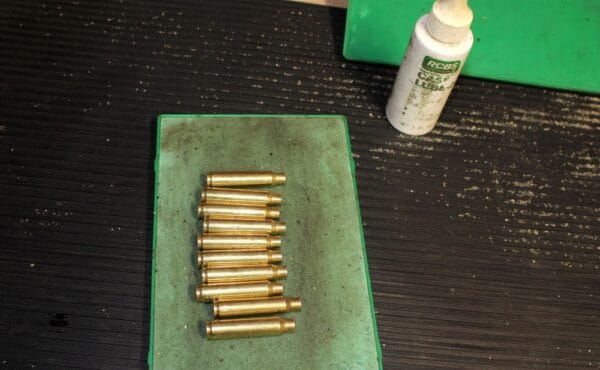

… so you need to lube them. Lubed cases are not optional unless you like digging stuck cases out of your die. You will need case lube and dies for the caliber(s) you load unless you own a carbide sizer die. This is bare-bones.
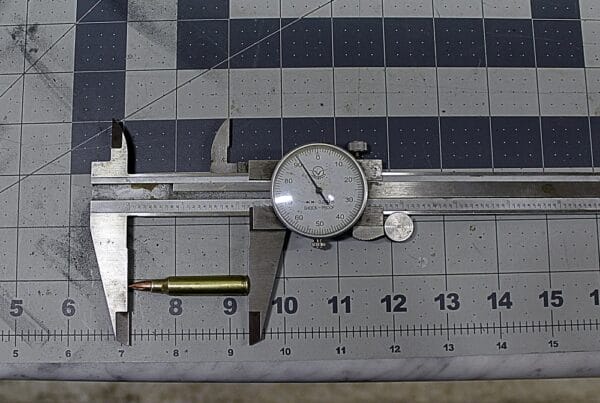

You should also invest in calipers of some sort (dial or digital), a bullet puller, and storage boxes for components and loaded rounds. The third tier of equipment that you should add later would include a case trimmer with different pilots, a tumbler to clean your cases, and a case deburring tool. I described all of these in the previous reloading article.
In terms of illustrations for this article, I will be using my Dillon Precision XL750 press, set up for .223. I chose to show one case as it goes through the process, for clarity. Normally, all stations would be full. This is a progressive press and, as such, produces a loaded round with each pull of the handle (once all the stations are full). You may want to consider a single-stage or turret press to get started with, but I wanted to show you the quickest way to produce loaded ammo. That would be with a progressive press. If you can swing one of those, you will be impressed with how quickly your ammo supply builds! For the differences between the types of presses, I will yet again refer to my original article. It explains the presses pretty well, along with other equipment.
The Manual
I waited until now to mention reloading manuals. A new reloader (or even an experienced one) needs at least one manual published by a company that makes bullets, powder, or reloading equipment. My go-to has been the Hornady manual for years. There is nothing wrong with any of the others… I’ve just worked with the company for previous reviews, and the folks at Hornady have always been extremely helpful. You can get this particular manual in a hard-bound book, e-book, or in the Hornady app.
Why not just get reloading data off the internet? Contrary to popular belief, everything printed on the good old interweb is not always true, good, or accurate. Unless you are getting data from a manufacturer, do yourself a favor and use verified data from a reputable manufacturer.
So… What Components Should I Buy?
As I mentioned earlier, you will need cases, bullets, primers, and powder. What you buy is determined by what type of shooting you’ll do.
Bullets. If you want to eradicate that pesky prairie dog town behind your back corn field, you would probably want a lighter varmint-type bullet that pretty much explodes on impact. What if you want to shoot paper or steel targets way out there? A heavier bullet with a good ballistic coefficient would be useful.
How about ammo to shoot those marauding tin cans in the back lot? Plain old inexpensive 55-grain FMJ bullets (similar to those I bought) would work. There are so many good bullets for sale out there that I won’t attempt to list them. Just remember to buy from a good dealer or manufacturer… don’t bet that the bullets that your cousin Bob’s gun-guy friend Tony sourced will be any good. Stick with major manufacturers or online bulk dealers that have great ratings. They are out there. I mentioned one above that I just dealt with and I’m happy.
Here’s something to remember… .223 rifles that have been around for a few years may have barrels that are rifled with a 1:10 or 1:12 twist. These twist rates are not best with heavier bullets — they were made pretty much for 55-grain bullets or lighter. If you want to shoot the full weight range of easily-obtained .223 bullets (from roughly 40 to 80 grains, in round numbers), make sure the barrel of your rifle has a faster twist like 1:8 or even 1:7. Most newer ARs will have this, as heavier bullets have gained in popularity. I don’t remember the last time I saw a .223 rifle with a slow twist.
Powder. There are about as many suitable powders for the .223 as there are Taylor Swift hit tunes. In a word, many. Some are better than others. I am using a powder that I bought from an LGS before it closed which is a military powder, WC844. It is the same as Hodgdon’s H335. It works very well and was cheap. But what if you are in your local gun store and are eyeing the powders on the shelf? What do you buy? Certain powders are perennial favorites for the .223. Here’s a short list:
- Hodgdon:
- Winchester:
- IMR:
- Alliant:
This is by no means a complete list but is simply meant to give you a place to start. There are tons of good powders out there, but like I said you need a starting place. Your reloading manual can help you decide what to buy. Some of these powders are better with lighter bullets, others, heavier ones… a few decent all-around powders are H335, Varget, and IMR 4895. The powder scene has changed a lot in the past few years. Several new, “high-tech” powders have been introduced such as CFE223. This powder has an additive that helps reduce copper fouling – hence its name, Copper Fouling Eraser.
I would pick up a pound of whatever your local folks have that’s good with .223 to start with. Load it, use it, and then on the next trip to the store, pick up a different type of powder to add to your powder collection as your budget allows. Powder (and primers) are just now starting to make a comeback after the COVID craziness, so hopefully, you can find some locally.
If you can’t find powder locally, for the addition of the HazMat fee (which ranges anywhere from about $23 to $50, depending on the seller and the shipper), you can order from a wide selection online. Just know that whether you order one pound of powder or many pounds, you’ll pay the same fee. Lots of reloaders pool their orders and split the fee up amongst themselves. Anyway, I needed to mention that. Primers are included on the HazMat party list, as well. Speaking of primers…
Primers. Primers are what make the gun go “bang”. Remember that cap gun you had as a kid and used it to sneak up on your sister and pop it in her ear? Sure, you never did that… Primers are like caps on steroids, but many times louder and more dangerous if used wrong. I’ve heard of shooters who were trying to impress their friends put a primer on a board and smack it with a hammer. There’s a reason that they only do it once. This is NOT a great “hold my beer” activity!
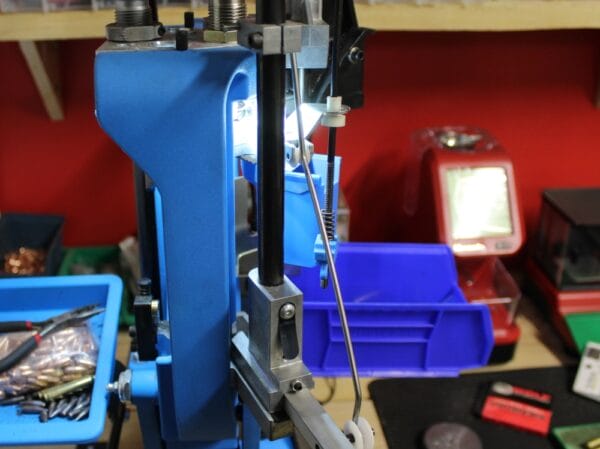

What – No Reloading Data?
This is where I would normally stick in mounds of reloading data in my typical reloading article. I will not do that here, though, because there is so much data out there. I wouldn’t know where to begin. The .223 is truly one popular cartridge, with scads of bullets in many weights and suitable powders available. So, instead of loading this article up with all sorts of data, allow me to state that all the major bullet and powder manufacturers publish data for their products. Some shooters like Hornady’s bullets… others Speer, Nosler, etc. So, go to those sites to gather tested data. Please… don’t just Google “223 reloading data” and go with what Joe Shooter says works the best. I’ve learned my lesson where using “unofficial” data is concerned. Stick with the major players and you’ll have no regrets.
The Process – What To Look For
Reloading the .223 is not hard. Some rifle calibers can be more of a trial, but not the .223. But, to produce finished .223 cartridges, you still need to follow the accepted reloading steps. I explained what those are in the first article of the series – again, the link is above. You might want to read that article if you haven’t already.
Here are a few things to keep in mind as you go about loading the .223…
- Remember that since you are loading a rifle cartridge with copper-jacketed bullets, flaring the case mouth as you would for lead bullets is not necessary, nor recommended. Just use the two dies that came with the set and seat the bullet normally.
- The .223 headspaces on its shoulder, so do not set the shoulder back. A trick I like to do to ensure I’m not sizing the shoulder is to take a Sharpie and make a vertical line on the case neck, from the shoulder up. (An alternative that won’t permanently mar your case is to take a lighter or candle and “smoke” the neck with a deposit of soot). Lube the case if you are using a “normal” (non-carbide) sizing die. Back the sizing die out 2 -3 turns and run the case into it. Check the line you drew… it should show where the die rubbed the ink off. Where does that end? How close to the shoulder? If it’s still above the shoulder, run the die in a turn or so. Repeat until the line is smudged as it “just kisses” the case shoulder.
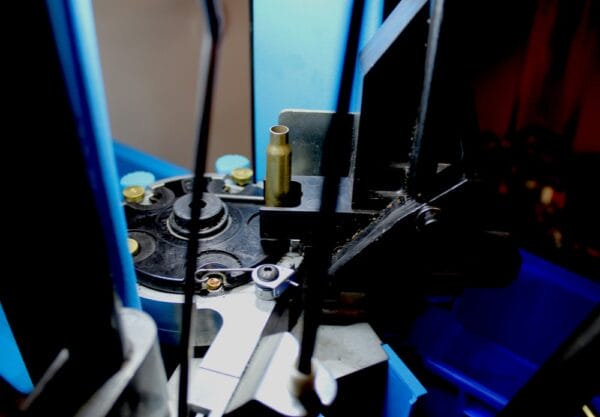

Here is station one, resizing (full-length) and decapping. This will size your cases without setting the shoulder back. I always use full-length-size cases I shoot in an autoloader like an AR or Ruger Mini. If you are shooting only in one bolt-action rifle and not sharing ammo with others, you might want to neck-size only. Just back your die off a turn so as not to touch the shoulder. This will take a bit of experimentation as you determine the least amount of sizing required that still allows the bolt to close easily. You will realize greater accuracy if you can do this, but for ammo intended for a semi-auto, I don’t recommend it. Full-length sizing is the way to go for that action.
- Two more basic things… make sure to insert bullets into case mouths before seating as straight as you can. It can make a difference. It could pull the neck out of round if the seating action has to straighten the bullet in addition to seating it. This is rare, but it’s something to think about. Also, make sure your primers are just below flush with the case head, and by no means should they protrude.
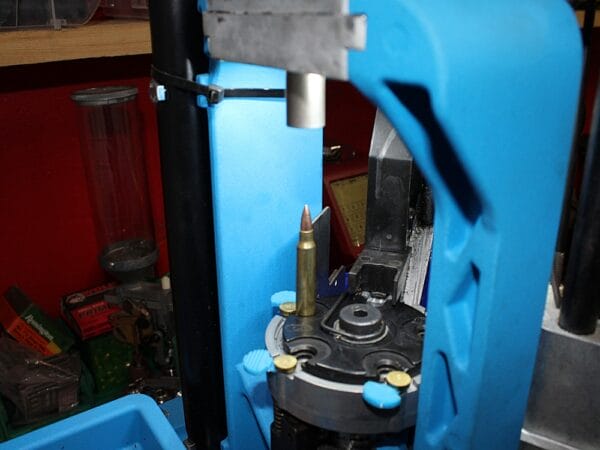

Station three: bullet seating/crimping. We’re showing the case in station five for photo clarity. - Lastly — this applies to everything you load — store your rifle loads properly. Make sure the bullet noses aren’t bumping around. This is a no-brainer, but you’d be surprised at the number of loaded cartridges I’ve seen put into Zip-lock bags and thrown into a shooting bag. Spring for some ammo boxes with labels!
And, In Conclusion…
Reloading the .223 is fun and easy. Just pay attention to the details. Time spent at your loading press is a good way to relax, but don’t get TOO relaxed… leave the Jack Daniels in the other room. “Rolling your own” can save you money and allow customization that factory ammo may not provide. The .223 is one of the easiest rifle cartridges I’ve loaded. Economics comes into the picture, too… being a .22 caliber, you won’t need as much powder as larger cartridges require, plus bullets are cheaper. Whether you load on a single stage, turret, or progressive press, get your components together and have fun! If you load .223, let’s hear from you below.
About Mike Hardesty
With experience spanning over 45 years, Mike Hardesty has long enjoyed shooting and reloading. An inveterate reloader, he casts bullets and reloads for a diverse array of firearms, each handled with long-practiced precision. Living in rural Indiana, his homestead boasts a personal 100-yard range where he shares his love for guns to his four sons, their wives, and eleven grandchildren. As a recognized author, his writings have been featured in notable platforms like Sniper Country, Bear Creek Arsenal Blog, Pew Pew Tactical, TTAG, Dillon Precision’s Blue Press, and Gun Made, revealing his ongoing passion for firearms at the age of 72.
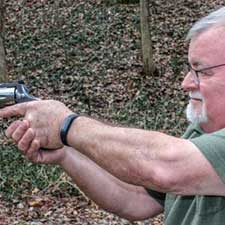

Some of the links on this page are affiliate links, meaning at no additional cost to you, Ammoland will earn a commission if you click through and make a purchase.

